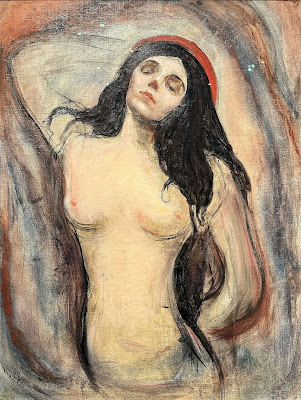Compared to a previous visit, we participants had much free time on this year's Hamburg trip, i.e., to stroll the many Christmas markets in the Hanseatic city. Christmas markets are not my thing, so I used half of my free afternoon and both of my free mornings for other activities.
On Wednesday morning, the day we left, I visited an exhibition at the Hamburger Kunsthalle that had just opened the week before. On the second floor of their new building, the museum had brought together pictures dealing with the "femme fatale."
I quickly entered the term "femme fatale" into the ChatGPT-mentioned above AI app, and here is what the Writing Assistant spit out:
Femmes fatales are women who have an aura of mystery and danger around them and are often seen as being sexually attractive and mysterious. They are often portrayed as being manipulative and using their sexuality to get what they want. They are often the villains or antagonists in stories and are often seen as being dangerous and irresistible to men.
ChatGPT's English is a bit bumpy and often is used too often, but the text alludes to the lust of men, i.e., painters and viewers alike, which Edvard Munch illustrated in the following lithograph.
Click the paintings for an enlargement.

|
| Edvard Munch, 1897, In the Man's Brain |

|
| Edvard Munch, 1894, Madonna |
Originally called Loving Woman, this picture can be taken to symbolize what Munch considered the
essential acts of the female life cycle: sexual intercourse, causing
fertilization, procreation, and death. Evidence for the first is in the
picture itself, an intensified, spiritualized variation in the nude of the
'mating' pose, the woman depicted as though recumbent beneath her lover …
Procreation was implied by the decoration of the original frame, later
discarded, on which were painted drops of semen and an embryo. That Munch
associated the image with death is clear from his own comments on the
picture, in which he sees it as representing the eternal cyclical process of
generation and decay in nature. He continually connected love with death:
for the man, because it eviscerated him, for the woman, because, following
Schopenhauer, he appears to have thought her function ended with
child-bearing.
To call the picture Madonna
is not inappropriate if the word is understood metaphorically, for Munch,
unable to accept Christianity or a personal god, regarded the continuous
generation and metamorphosis of life in a religious light, subsuming its
spiritual as well as its material components. The blood-red halo around the
woman's head could be considered the spiritual counterpart to the touches of
red on her lips, nipples, and navel. She seems to float within curving bands
of colored light suggestive of Art Nouveau. Far from deforming her, however,
they look like a supernatural emanation, possibly deriving from the
spiritualist notion of an aura surrounding all individuals but only visible
to mediums.

|
| Carl Joseph Begas, 1835, The Lureley |

|
| Heine's fair copy of Die Loreley |
|
Die Loreley
Ich weiß nicht, was soll es bedeuten Daß ich so traurig bin; Ein Märchen aus alten Zeiten Das kommt mir nicht aus dem Sinn. Die Luft ist kühl und es dunkelt, Und ruhig fließt der Rhein; Der Gipfel des Berges funkelt Im Abendsonnenschein. Die schönste Jungfrau sitzet Dort oben wunderbar, Ihr goldnes Geschmeide blitzet, Sie kämmt ihr goldenes Haar. Sie kämmt es mit goldenem Kamme Und singt ein Lied dabei, Das hat eine wundersame, Gewaltige Melodei. Den Schiffer im kleinen Schiffe Ergreift es mit wildem Weh, Er schaut nicht die Felsenrisse, Er schaut nur hinauf in die Höh. Ich glaube, die Wellen verschlingen Am Ende Schiffer und Kahn. Und das hat mit ihrem Singen Die Lorelei getan. |
Lorelei
I don't know what it means, That I am so sad; A tale from the old days, Won't get it out of my head. The air is cool, and it's dark, And calmly flows the Rhine; The summit of the mountain sparkles In the evening sunshine. The most beautiful virgin Sits wonderfully up there; Her golden jewels flash, She combs her golden hair. She combs it with a golden comb, While doing so, she sings a song; That has a wondrous, A mighty melody. The skipper in the little ship It seizes him with wild pain; He does not look at the rocky reefs, He only looks up to the heights. I think in the end The waves swallow up the skipper and barge. And that with her singing Has done the Lorelei. |
Both paintings depict Lorelei as an adorned woman, not necessarily seductive or even cruel.

|
|
Julius Hübner, 1828, The Fisher Boy and the Mermaid |

|
| Dante Gabriel Rossetti, 1863, Helen of Troy |

|
| Evelyn de Morgan, ~ 1900, Medea |

|
| Herbert James Draper, 1904, The Golden Fleece. |

|
|
Alfons Mucha, 1998, Medea. In the title role, Sarah Bernhardt had mad eyes. |
On his long journey, Ulysses was often tempted by women. The
sorceress Circe turned his companions into pigs.
The Bible knows many fatal women.

|
| Max Liebermann, 1902, Samson and Delilah |
A vicarious victory? As a surrogate of Samson's manhood, Dalilah holds Samson's severed lock triumphantly toward
the sky.
Is the painter's fantasy going overboard?
Male gazes drive the market for depictions of femmes fatales.
Hetaira Phryne was prosecuted for άσέβεια (impiety) and defended by
Hypereides. He exposed Phryne's breasts to the jury, who were so struck by
her beauty that she was acquitted. Only a few men remain seated in stoic calm.
Lucrezia's dance is eagerly commented on, and some men cast lascivious
looks.
**














No comments:
Post a Comment